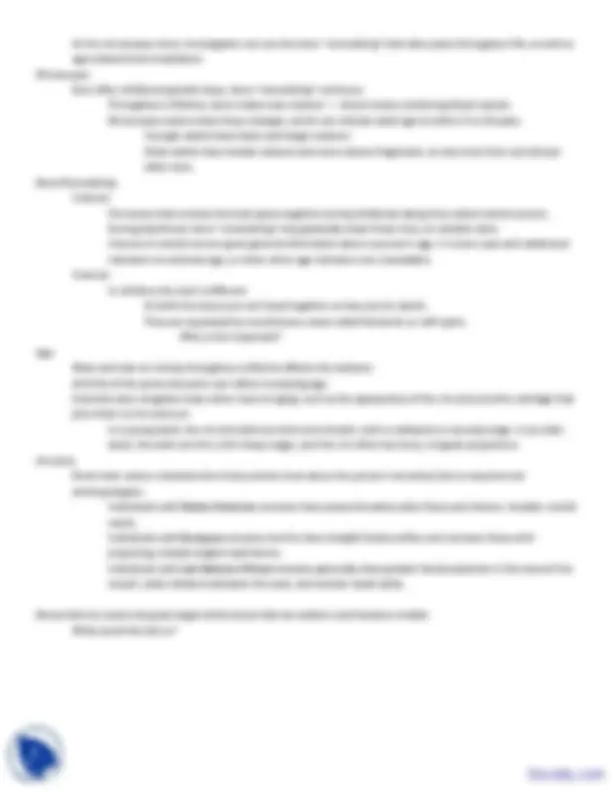



Study with the several resources on Docsity

Earn points by helping other students or get them with a premium plan


Prepare for your exams
Study with the several resources on Docsity

Earn points to download
Earn points by helping other students or get them with a premium plan
Community
Ask the community for help and clear up your study doubts
Discover the best universities in your country according to Docsity users
Free resources
Download our free guides on studying techniques, anxiety management strategies, and thesis advice from Docsity tutors
Forensic science (often shortened to forensics) is the application of a broad spectrum of sciences and technologies to investigate and establish facts of interest in relation to criminal or civil law. This lecture includes: Anthropology, Physical Anthropologists, Forensic Anthropologists, Interesting Fact, Particularly a Crime, Smithsonian, Forensic Laboratories, Ancestry, Right or Left Handed, Behavioral Information
Typology: Study notes
1 / 3

This page cannot be seen from the preview
Don't miss anything!


Physical anthropologists (study of the skeleton and how it evolved) Forensic anthropologists Physical anthropologists who specialize in recovering and examining human skeletal remains where legal questions are involved (particularly a crime has been committed) Began in 1939. Used in the 1940’s to identify dead WWII soldiers. First book wasn’t written until 1979. Interesting Fact The first time a forensic anthropologist was called to testify in court involved a case in 1897. A Chicago murderer turned his victim’s body into sausage leaving behind no body to tie him to the crime. Luckily, bone fragments were found at the factory and a physical anthropologist was able to identify them as human remains. Where do they work? Usually, Universities and major research facilities (like the Smithsonian). They are usually consulted on a “as needed” basis by forensic laboratories. What can you tell from bones? Age Sex Height Ancestry Right or left handed Behavioral information Medical conditions Childbirth Past injuries or accidents Occasionally: Time of death Cause of death Are these remains human? About 25% of the time, the remains are actually non-human. Can be distinguished by size, structure, or under a microscope. How many individuals are here? Try to identify the minimum number that must be present. Duplication of bones is the easiest way Differences in age, size, structure, and preservation DNA can be used to confirm Sex Much easier once puberty has been reached. Skeletons of children often remain unsexed. What’s the best bone to use for sex? The Pelvis It is much wider in women to allow for childbirth The sacrum is shorter and wider in a female The coccyx is more moveable in a female Pelvic bones are lighter and smoother in a female Sex
Differences can also be seen in the skull The female skull is smaller and rounder. The female forehead is vertically longer The female jaw is smaller. The male chin is more square (less rounded) and their foreheads protrude further Males have a larger brow ridge, mastoid process (part of the temporal bone), and external occipital protuberance (sticks down from the back of the skull) Age Easiest to determine on infants and children since growth rate is pretty standard. From toddler to 21 the best indicator of age is teeth Harder to determine after puberty. In adults the best indicator of age is the pelvis Bones remain constant in length as a adult until about 35 after which bone loss occurs faster than repair and bones get shorter. Children A baby's bones begin to grow in the womb. At birth, the skeleton is partially formed. Many bones are still in "parts.“ The ends (epiphyses) and bony shafts (diaphyses) of long bones form separately in the womb. At birth, the ends of the long bones are mainly cartilage, with centers of bone beginning to form inside. As a child grows, the shafts get longer, and bone gradually replaces the cartilage epiphyses. Through the growing years, a layer of cartilage (the growth plate) separates each epiphyses from the bone shaft. Children Between 17 and 25 years, normal growth stops. The development and union of separate bone parts is complete. At this point, you and your skeleton are as tall as you are going to get - with many fewer bone parts than you started with! Measuring the length of long bones can give an estimate of age for children, but this technique is useful only until bones have stopped growing. Children The clavicle (collar bone)is the last bone to complete growth, at about age 25. The tibia completes growth at about age 16 or 17 in girls, and 18 or 19 in boys. Teeth Like many other mammals, humans have two sets of teeth. "Baby" teeth (also called milk or deciduous teeth) start coming in at about 6 months, beginning with the central incisors in the mandible (lower jaw). Each tooth type (incisors, canines, premolars, molars) erupts on a predictable schedule. Permanent teeth begin to replace deciduous teeth at about 6 years and finish erupting by about 21 years of age. X-rays provide views of the unerupted permanent teeth and tooth roots still within the bone. The crown of a tooth forms first, followed by the root. Scientists estimate age by comparing the stage of tooth formation in the X-rays and bone with know dental growth standards. Adults Skeletons record an adult's age in several ways. The surfaces of the cranium, pubic bones, and rib ends hold clues.